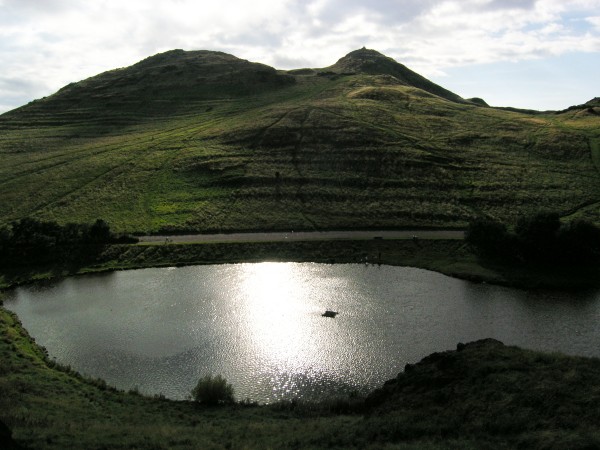![]() When you live in Edinburgh, you can’t ignore geology even if you were foolish enough to want to: the summit of Arthur’s Seat is visible from virtually every decent vantage point in the city.
When you live in Edinburgh, you can’t ignore geology even if you were foolish enough to want to: the summit of Arthur’s Seat is visible from virtually every decent vantage point in the city.
The guidebooks will tell you that Arthur’s seat is an extinct volcano that erupted during the early Carboniferous, around 350 million years ago (that’s the Mississipian for you American geologists). This is true in a sense, but although it might be easy to picture lava spewing from today’s summit, the landform we see today is but a pale shadow of the volcano-that-was. One big clue is the Salisbury Crags, a volcanic sill that must have been originally intruded some distance below the surface, and has since been excavated by erosion.

Arthur's Seat with the Salisbury Crags in the foreground (click for a larger version). Photo: Chris Rowan, 2009.
The summit of Arthur’s Seat is in fact formed around a couple of volcanic pipes, yet more volcanic intrusions that formed in the shaft leading to vents of the original volcano (like the peak Edinburgh Castle is built on). Thus we are again seeing rocks that were nowhere near the top of the mountain when they formed.

Arthur's seat viewed from its east flank. The two peaks are both formed around pipes of intrusive dolerite. The poorly exposed rocks in the foreground are volcanic ash flows (click for a larger version). Photo: Chris Rowan, 2009
So if we’re being truly accurate, Arthur’s Seat is the highly eroded core of an extinct volcano; a peek at its internal magmatic plumbing. The fact it still looks a bit like a volcano is a coincidence: the summit has formed around the original vent because the intruded dolerites are harder and more resistant to erosion than the ash flows and lavas that formed the rest of the volcanic edifice. And there has been a lot of erosion, most recently by glaciers in the last ice ages. Which brings us to today’s mind-boggling little geological observation: magma erupted over a few tens of thousands of years, 350 million years ago, is still controlling the shape of the landscape today.




Comments (5)